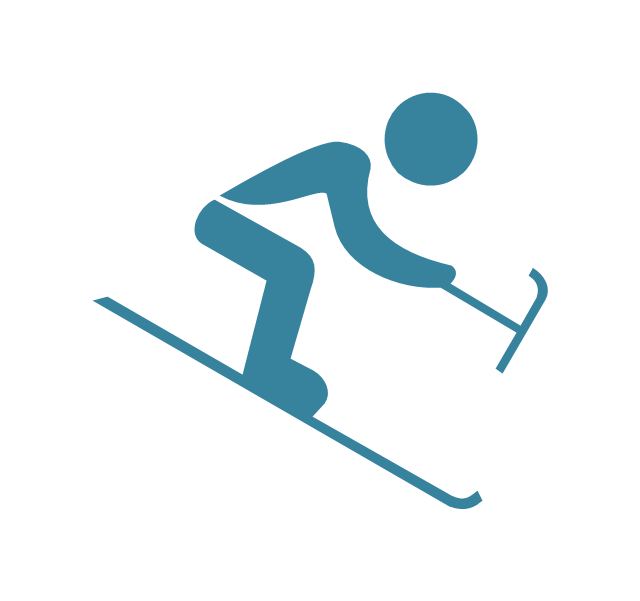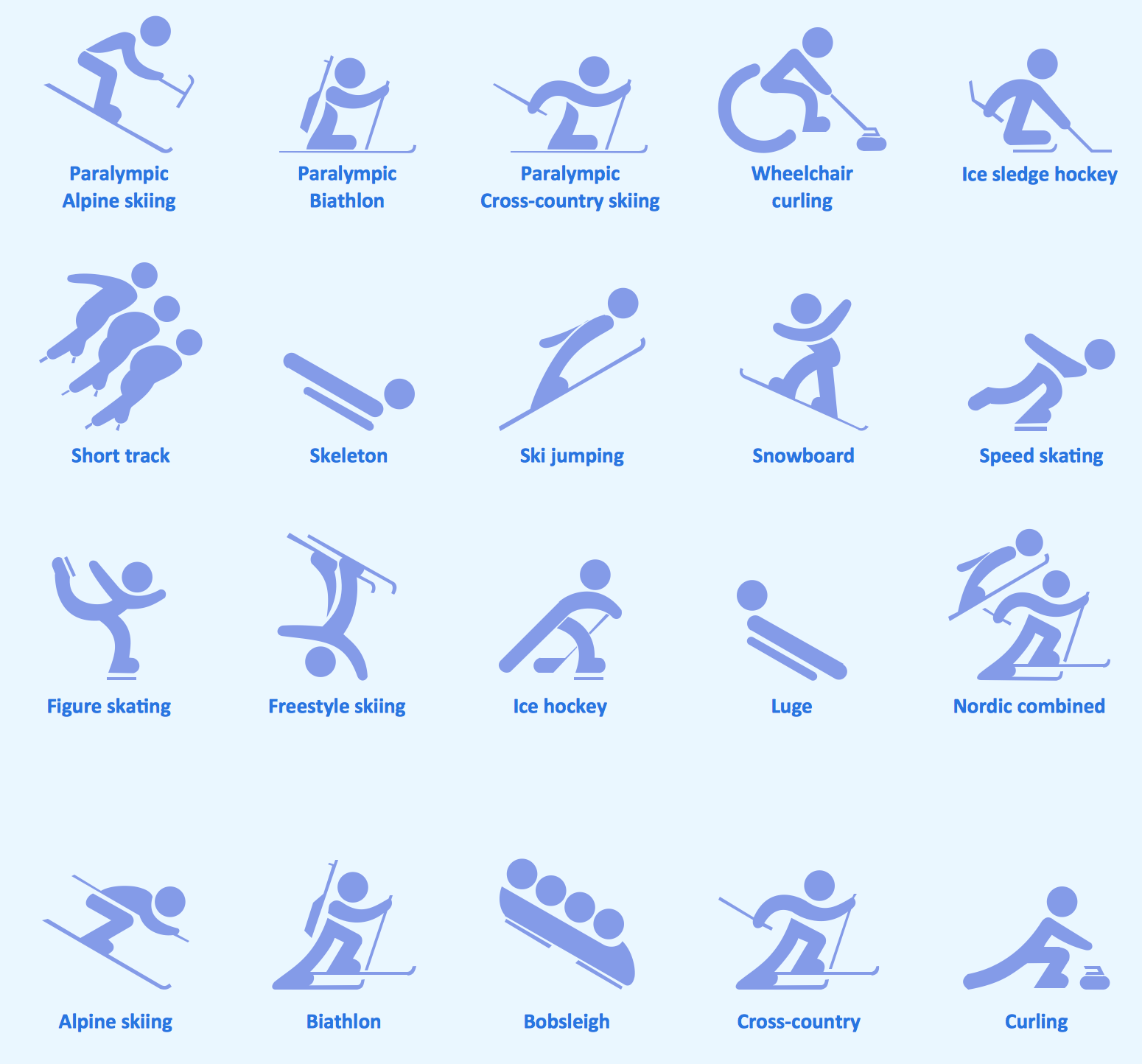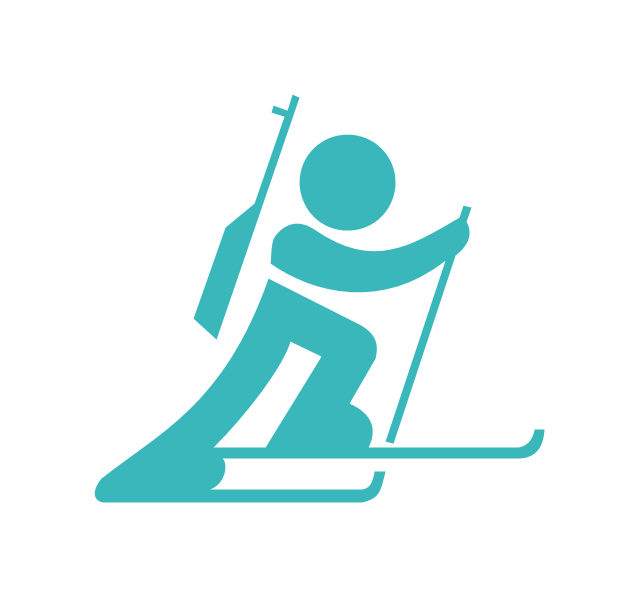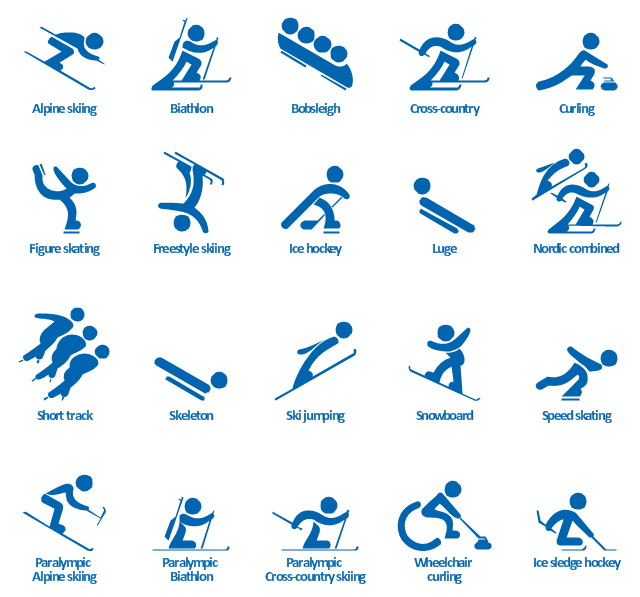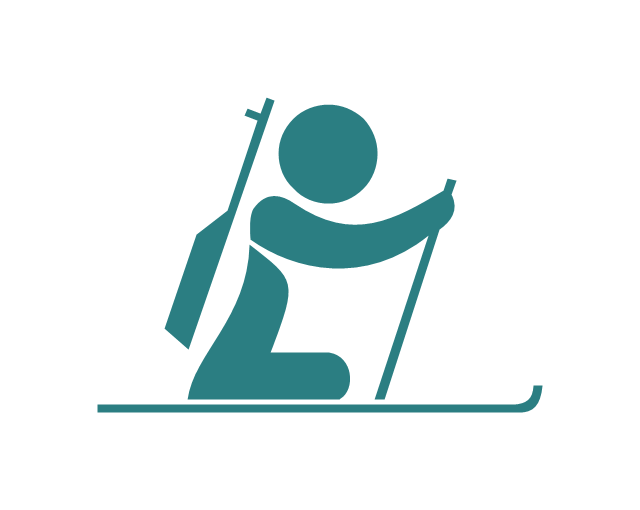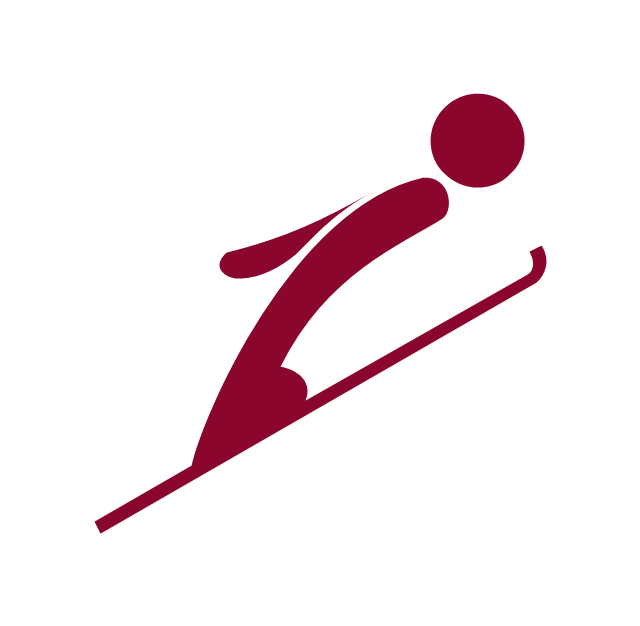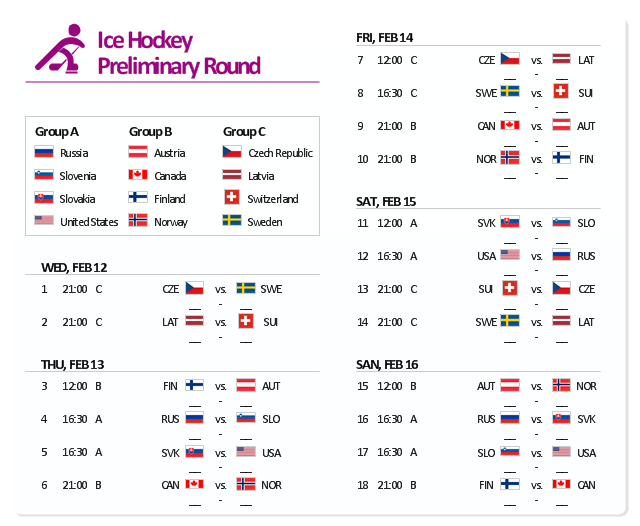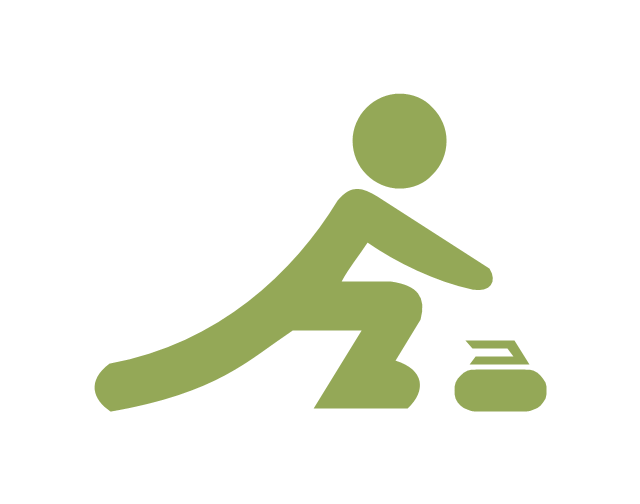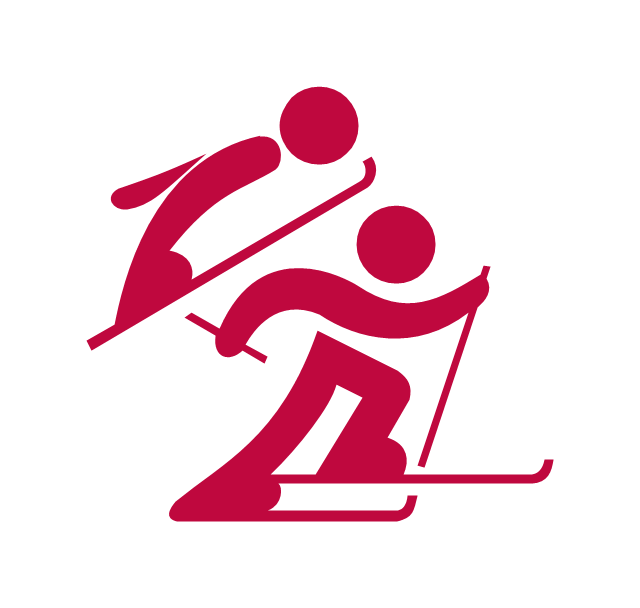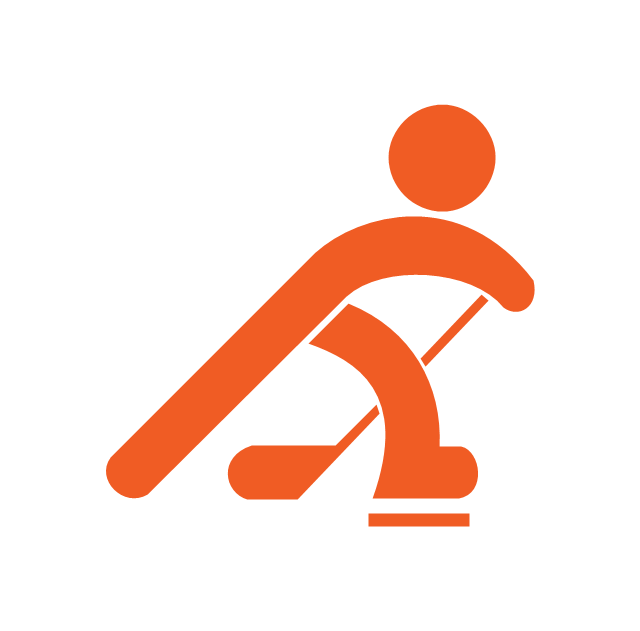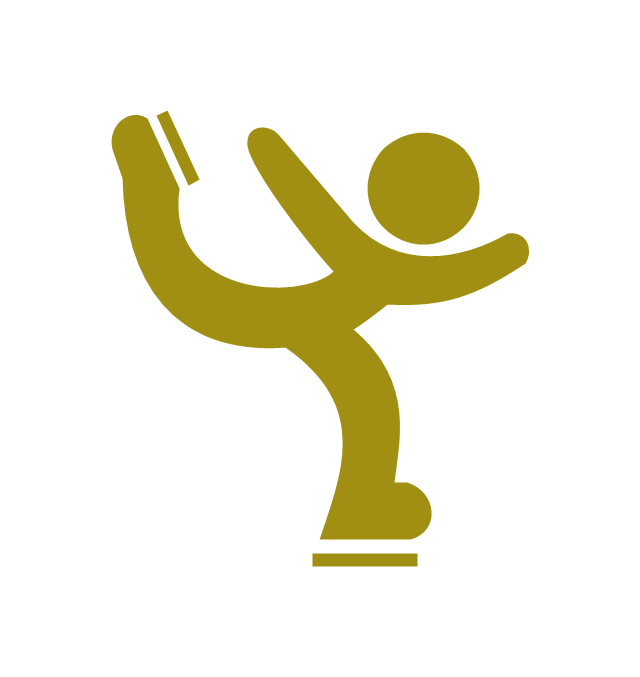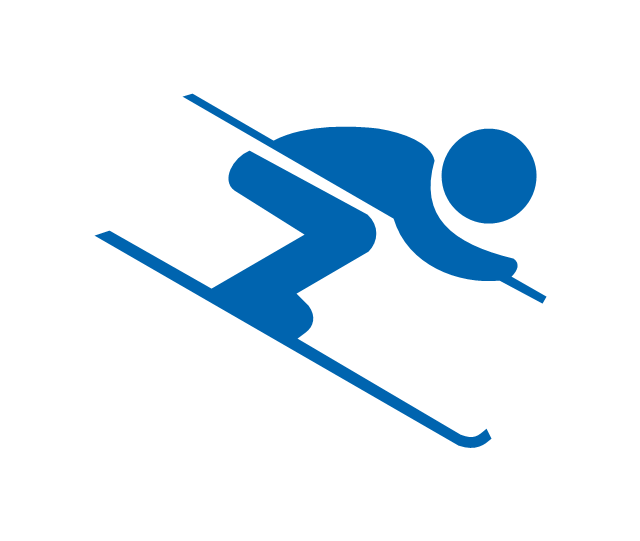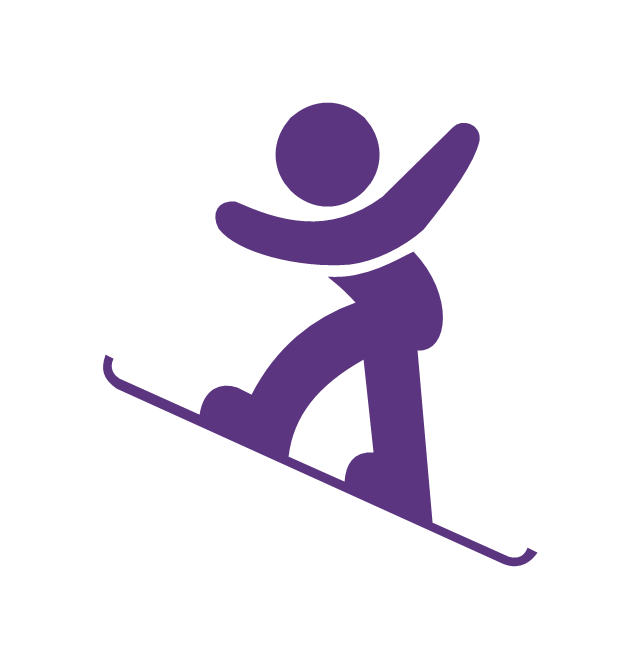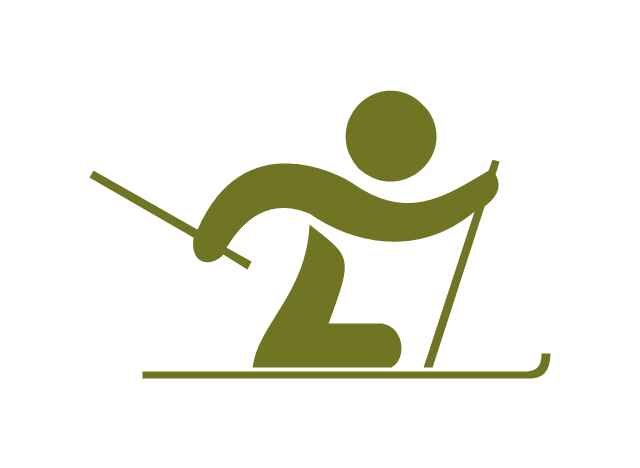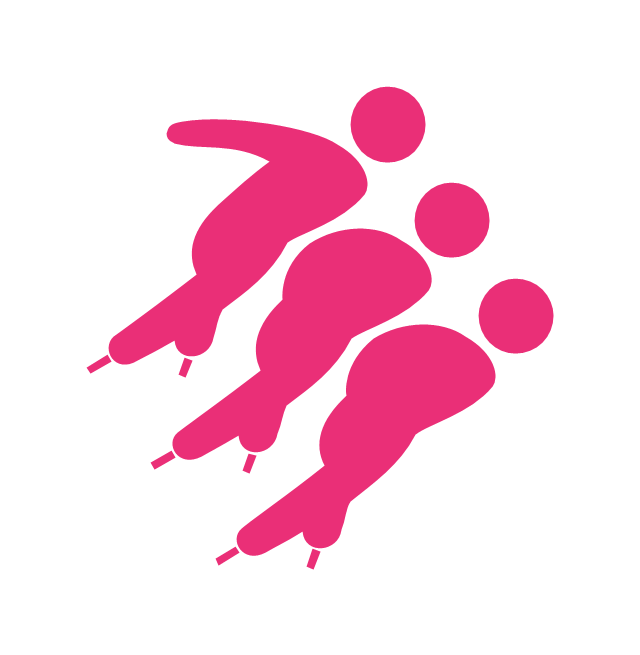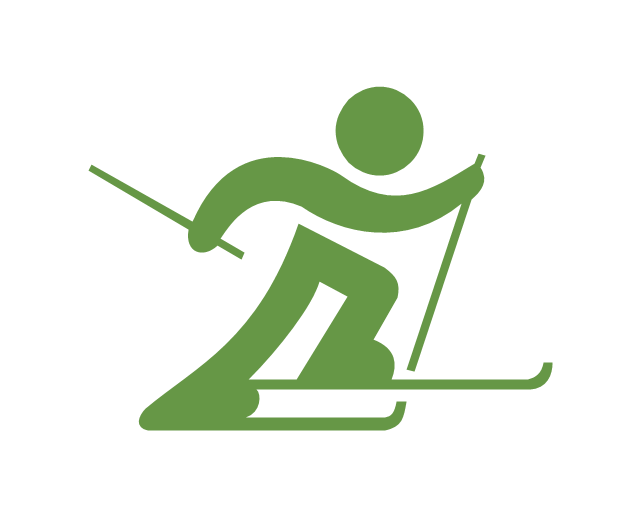"Skeleton is a fast winter sliding sport in which an individual person rides a small sled down a frozen track while lying face down, during which athletes experience forces up to 5g. It originated in St. Moritz, Switzerland as a spin-off from the popular British sport of Cresta sledding. Although skeleton "sliders" use equipment similar to that of Cresta "riders", the two sports are different: while skeleton is run on the same track used by bobsleds and luge, Cresta is run on Cresta-specific sledding tracks only. Skeleton sleds are steered using torque provided by the head and shoulders. The Cresta toboggan does not have a steering or braking mechanism although the Cresta riders use rakes on their boots in addition to shifting body weight to help steer and brake. The sport of skeleton can be traced to 1882, when soldiers in Switzerland constructed a toboggan track between the towns of Davos and Klosters. While toboggan tracks were not uncommon at the time, the added challenge of curves and bends in the Swiss track distinguished it from those of Canada and the United States. ...
In 1923, the Federation Internationale de Bobsleigh et de Tobogganing (FIBT) was established as the governing body of the sport. Soon afterward, in 1926, the International Olympic Committee declared bobsleigh and skeleton as Olympic sports and adopted the rules of the St. Moritz run as the officially recognized Olympic rules. It was not until 2002, however, that skeleton itself was added permanently to the Olympic program with the 2002 Winter Olympics in Salt Lake City, Utah." [Skeleton (sport). Wikipedia]
The vector icon example "Skeleton" represents one of 20 symbols from the Winter sports pictograms library for the ConceptDraw PRO diagramming and vector drawing software.
The design elements library Winter sports pictograms is included in the Winter Sports solution from the Sport area of ConceptDraw Solution Park. www.conceptdraw.com/ solution-park/ sport-winter
In 1923, the Federation Internationale de Bobsleigh et de Tobogganing (FIBT) was established as the governing body of the sport. Soon afterward, in 1926, the International Olympic Committee declared bobsleigh and skeleton as Olympic sports and adopted the rules of the St. Moritz run as the officially recognized Olympic rules. It was not until 2002, however, that skeleton itself was added permanently to the Olympic program with the 2002 Winter Olympics in Salt Lake City, Utah." [Skeleton (sport). Wikipedia]
The vector icon example "Skeleton" represents one of 20 symbols from the Winter sports pictograms library for the ConceptDraw PRO diagramming and vector drawing software.
The design elements library Winter sports pictograms is included in the Winter Sports solution from the Sport area of ConceptDraw Solution Park. www.conceptdraw.com/ solution-park/ sport-winter
"Paralympic alpine skiing is an adaptation of alpine skiing for athletes with a disability. The sport evolved from the efforts of disabled veterans in Germany and Austria during and after the Second World War. The sport is governed by the International Paralympic Committee Sports Committee. The primary equipment used includes outrigger skis, sit-skis, and mono-skis. Para-alpine skiing disciplines include the Downhill, Super-G, Giant Slalom, Slalom, Super Combined and Snowboard.
Para-alpine skiing classification is the classification system for para-alpine skiing designed to insure fair competition between alpine skiers with different types of disabilities. The classifications are grouped into three general disability types: standing, blind and sitting. A factoring system was created for para-alpine skiing to allow the three classification groupings to fairly compete against each other in the same race despite different functional skiing levels and medical issues.
Alpine skiing was one of the foundation sports at the first Winter Paralympics in 1976 with Slalom and Giant Slalom events being held. Different disciplines were added to the Paralympic programme over time. The 2010 Winter Paralympics para-alpine skiing events were held at Whistler Creekside. The disciplines at Whistler included Downhill, Super-Combined, Super-G, Slalom and Giant Slalom." [Para-alpine skiing. Wikipedia]
The vector icon example "Alpine skiing, paralympic" represents one of 20 symbols from the Winter sports pictograms library for the ConceptDraw PRO diagramming and vector drawing software.
The design elements library Winter sports pictograms is included in the Winter Sports solution from the Sport area of ConceptDraw Solution Park. www.conceptdraw.com/ solution-park/ sport-winter
Para-alpine skiing classification is the classification system for para-alpine skiing designed to insure fair competition between alpine skiers with different types of disabilities. The classifications are grouped into three general disability types: standing, blind and sitting. A factoring system was created for para-alpine skiing to allow the three classification groupings to fairly compete against each other in the same race despite different functional skiing levels and medical issues.
Alpine skiing was one of the foundation sports at the first Winter Paralympics in 1976 with Slalom and Giant Slalom events being held. Different disciplines were added to the Paralympic programme over time. The 2010 Winter Paralympics para-alpine skiing events were held at Whistler Creekside. The disciplines at Whistler included Downhill, Super-Combined, Super-G, Slalom and Giant Slalom." [Para-alpine skiing. Wikipedia]
The vector icon example "Alpine skiing, paralympic" represents one of 20 symbols from the Winter sports pictograms library for the ConceptDraw PRO diagramming and vector drawing software.
The design elements library Winter sports pictograms is included in the Winter Sports solution from the Sport area of ConceptDraw Solution Park. www.conceptdraw.com/ solution-park/ sport-winter
"A 'Luge' ... is a small one- or two-person sled on which one sleds supine (face up) and feet-first. Steering is done by flexing the sled's runners with the calf of each leg or exerting opposite shoulder pressure to the seat. ... Luge is also the name of an Olympic sport. Of the three Olympic sliding sports, which include bobsleigh and skeleton, luge is the fastest and most dangerous. Lugers can reach speeds of 140 km per hour (87 mph). ...
Street luge is a recent innovation of the sport. It is considered an extreme sport, as well as an Olympic sport.
Lugers compete against a timer and are timed to a thousandth of a second, making luge one of the most precisely timed sports in the world." [Luge. Wikipedia]
The vector icon example "Luge" represents one of 20 symbols from the Winter sports pictograms library for the ConceptDraw PRO diagramming and vector drawing software.
The design elements library Winter sports pictograms is included in the Winter Sports solution from the Sport area of ConceptDraw Solution Park. www.conceptdraw.com/ solution-park/ sport-winter
Street luge is a recent innovation of the sport. It is considered an extreme sport, as well as an Olympic sport.
Lugers compete against a timer and are timed to a thousandth of a second, making luge one of the most precisely timed sports in the world." [Luge. Wikipedia]
The vector icon example "Luge" represents one of 20 symbols from the Winter sports pictograms library for the ConceptDraw PRO diagramming and vector drawing software.
The design elements library Winter sports pictograms is included in the Winter Sports solution from the Sport area of ConceptDraw Solution Park. www.conceptdraw.com/ solution-park/ sport-winter
Sport pictograms. Olympic Games
The Winter Sports solution from Sport Area of ConceptDraw Solution Park contains winter sports pictograms you may use illustrating any kind of material about Olympic Games or any other sport competitions."Biathlon is any sporting event made up of two disciplines. However, biathlon usually refers specifically to the winter sport that combines cross-country skiing and rifle shooting. Other popular variants include summer biathlon, which combines cross-country running with rifle, and biathle (also known as "modern biathlon"), which combines running with swimming." [Biathlon. Wikipedia]
The vector icon example "Biathlon" represents one of 20 symbols from the Winter sports pictograms library for the ConceptDraw PRO diagramming and vector drawing software.
The design elements library Winter sports pictograms is included in the Winter Sports solution from the Sport area of ConceptDraw Solution Park. www.conceptdraw.com/ solution-park/ sport-winter
The vector icon example "Biathlon" represents one of 20 symbols from the Winter sports pictograms library for the ConceptDraw PRO diagramming and vector drawing software.
The design elements library Winter sports pictograms is included in the Winter Sports solution from the Sport area of ConceptDraw Solution Park. www.conceptdraw.com/ solution-park/ sport-winter
The vector stencils library "Winter sports pictograms" contains 20 symbols of Winter Olympic sports: Alpine skiing, Alpine skiing paralympic, Biathlon, Biathlon paralympic, Bobsleigh, Cross-country, Cross-country skiing paralympic, Curling, Wheelchair curling, Figure skating, Freestyle skiing, Ice hockey, Ice sledge hockey, Luge, Nordic combined, Short track, Skeleton, Ski jumping, Snowboard, Speed skating.
The design elements library "Winter sports pictograms" for the ConceptDraw PRO diagramming and vector drawing software is included in the Winter Sports solution from the Sport area of ConceptDraw Solution Park.
www.conceptdraw.com/ solution-park/ sport-winter
The design elements library "Winter sports pictograms" for the ConceptDraw PRO diagramming and vector drawing software is included in the Winter Sports solution from the Sport area of ConceptDraw Solution Park.
www.conceptdraw.com/ solution-park/ sport-winter
"Paralympic biathlon is an adaptation of biathlon for athletes with a disability. Paralympic biathlon is one of two Nordic skiing disciplines in the Winter Paralympic Games. It is governed by the International Paralympic Committee.
Paralympic biathlon includes standing events, sitting events (for wheelchair users), and events for visually impaired athletes.
Visually impaired athletes use a rifle that use sound to indicate to the athlete how accurate their aim is, and shoots a laser beam at the target." [Paralympic biathlon. Wikipedia]
The vector icon example "Biathlon, paralympic" represents one of 20 symbols from the Winter sports pictograms library for the ConceptDraw PRO diagramming and vector drawing software.
The design elements library Winter sports pictograms is included in the Winter Sports solution from the Sport area of ConceptDraw Solution Park. www.conceptdraw.com/ solution-park/ sport-winter
Paralympic biathlon includes standing events, sitting events (for wheelchair users), and events for visually impaired athletes.
Visually impaired athletes use a rifle that use sound to indicate to the athlete how accurate their aim is, and shoots a laser beam at the target." [Paralympic biathlon. Wikipedia]
The vector icon example "Biathlon, paralympic" represents one of 20 symbols from the Winter sports pictograms library for the ConceptDraw PRO diagramming and vector drawing software.
The design elements library Winter sports pictograms is included in the Winter Sports solution from the Sport area of ConceptDraw Solution Park. www.conceptdraw.com/ solution-park/ sport-winter
"Bobsleigh or bobsled is a winter sport in which teams of two or four make timed runs down narrow, twisting, banked, iced tracks in a gravity-powered sled. The timed runs are combined to calculate the final score.
The various types of sleds came several years before the first tracks were built in St. Moritz, Switzerland, where the original bobsleds were adapted upsized luge/ skeleton sleds designed by the adventurously wealthy to carry passengers. All three types were adapted from boys' delivery sleds and toboggans.
Competition naturally followed, and to protect the working class and rich visitors in the streets and byways of St Moritz, bobsledding was eventually banned from the public highway. In the winter of 1903/ 1904 the Badrutt family, owners of the historic KulmHotel and the Palace Hotel, allowed Emil Thoma to organise the construction of the first familiarly configured 'half-pipe' track in the Kulm Hotel Park, ending in the village of Cresta. It has hosted the sport during two Olympics and is still in use today.
International bobsleigh competitions are governed by the Fédération Internationale de Bobsleigh et de Tobogganing (FIBT). National competitions are often governed by bodies such as the United States Bobsled and Skeleton Federation and Bobsleigh Canada Skeleton." [Bobsleigh. Wikipedia]
The vector icon example "Bobsleigh" represents one of 20 symbols from the Winter sports pictograms library for the ConceptDraw PRO diagramming and vector drawing software.
The design elements library Winter sports pictograms is included in the Winter Sports solution from the Sport area of ConceptDraw Solution Park. www.conceptdraw.com/ solution-park/ sport-winter
The various types of sleds came several years before the first tracks were built in St. Moritz, Switzerland, where the original bobsleds were adapted upsized luge/ skeleton sleds designed by the adventurously wealthy to carry passengers. All three types were adapted from boys' delivery sleds and toboggans.
Competition naturally followed, and to protect the working class and rich visitors in the streets and byways of St Moritz, bobsledding was eventually banned from the public highway. In the winter of 1903/ 1904 the Badrutt family, owners of the historic KulmHotel and the Palace Hotel, allowed Emil Thoma to organise the construction of the first familiarly configured 'half-pipe' track in the Kulm Hotel Park, ending in the village of Cresta. It has hosted the sport during two Olympics and is still in use today.
International bobsleigh competitions are governed by the Fédération Internationale de Bobsleigh et de Tobogganing (FIBT). National competitions are often governed by bodies such as the United States Bobsled and Skeleton Federation and Bobsleigh Canada Skeleton." [Bobsleigh. Wikipedia]
The vector icon example "Bobsleigh" represents one of 20 symbols from the Winter sports pictograms library for the ConceptDraw PRO diagramming and vector drawing software.
The design elements library Winter sports pictograms is included in the Winter Sports solution from the Sport area of ConceptDraw Solution Park. www.conceptdraw.com/ solution-park/ sport-winter
"Ski jumping is a sport in which skiers go down a take-off ramp, jump and attempt to land as far as possible down the hill below. In addition to the length of the jump, judges give points for style. The skis used for ski jumping are wide and long (260 to 275 centimetres (100 to 108 in)). Ski jumping is predominantly a winter sport, performed on snow, and is part of the Winter Olympic Games, but can also be performed in summer on artificial surfaces – porcelain or frost rail track on the inrun, plastic on the landing hill. Ski jumping belongs to the nordic type of competitive skiing." [Ski jumping. Wikipedia]
The vector icon example "Ski jumping" represents one of 20 symbols from the Winter sports pictograms library for the ConceptDraw PRO diagramming and vector drawing software.
The design elements library Winter sports pictograms is included in the Winter Sports solution from the Sport area of ConceptDraw Solution Park. www.conceptdraw.com/ solution-park/ sport-winter
The vector icon example "Ski jumping" represents one of 20 symbols from the Winter sports pictograms library for the ConceptDraw PRO diagramming and vector drawing software.
The design elements library Winter sports pictograms is included in the Winter Sports solution from the Sport area of ConceptDraw Solution Park. www.conceptdraw.com/ solution-park/ sport-winter
The example "Sochi 2014 Olympics - Men’s hockey tournament schedule" represent Ice Hockey schedule of XXII Olympic Winter Games according to Sochi2014.com website. [sochi2014.com/ en/ ice-hockey-schedule-and-results]
"The 2014 Winter Olympics, officially the XXII Olympic Winter Games, or the 22nd Winter Olympics, are scheduled to take place from 6 to 23 February 2014, in Sochi, Russia, with some events held in the resort town of Krasnaya Polyana. Ninety-eight events in fifteen winter sports will be held. Both the Olympics and 2014 Winter Paralympics are being organized by the Sochi Organizing Committee (SOC). ...
The events of the 2014 Winter Olympics will be held around two clusters of new venues; an Olympic Park was constructed in the Imeretinsky Valley on the coast of the Black Sea, with Fisht Olympic Stadium and the Games' indoor venues located within walking distance, and snow events will be held at Krasnaya Polyana." [2014 Winter Olympics. Wikipedia]
The example "Sochi 2014 Olympics - Men’s hockey tournament schedule" was created using the ConceptDraw PRO diagramming and vector drawing software extended with the Winter Sports solution. The Winter Sports solution from the Sport area of ConceptDraw Solution Park contains the vector stencils library "Winter sports pictograms" and examples of diagrams and infographics.
www.conceptdraw.com/ solution-park/ sport-winter
"The 2014 Winter Olympics, officially the XXII Olympic Winter Games, or the 22nd Winter Olympics, are scheduled to take place from 6 to 23 February 2014, in Sochi, Russia, with some events held in the resort town of Krasnaya Polyana. Ninety-eight events in fifteen winter sports will be held. Both the Olympics and 2014 Winter Paralympics are being organized by the Sochi Organizing Committee (SOC). ...
The events of the 2014 Winter Olympics will be held around two clusters of new venues; an Olympic Park was constructed in the Imeretinsky Valley on the coast of the Black Sea, with Fisht Olympic Stadium and the Games' indoor venues located within walking distance, and snow events will be held at Krasnaya Polyana." [2014 Winter Olympics. Wikipedia]
The example "Sochi 2014 Olympics - Men’s hockey tournament schedule" was created using the ConceptDraw PRO diagramming and vector drawing software extended with the Winter Sports solution. The Winter Sports solution from the Sport area of ConceptDraw Solution Park contains the vector stencils library "Winter sports pictograms" and examples of diagrams and infographics.
www.conceptdraw.com/ solution-park/ sport-winter
"Curling is a sport in which players slide stones across a sheet of ice towards a target of four concentric rings. It is related to bowls, boule and shuffleboard. Two teams, each of four players, take turns sliding heavy, polished granite stones, also called "rocks", across the ice curling sheet towards the house, a circular target marked on the ice. Each team has eight stones. The purpose is to accumulate the highest score for a game; points are scored for the stones resting closest to the centre of the house at the conclusion of each end, which is completed when both teams have thrown all of their stones. A game may consist of ten or eight ends.
The curler can induce a curved path by causing the stone to slowly turn as it slides, and the path of the rock may be further influenced by two sweepers with brooms who accompany it as it slides down the sheet, using the brooms to alter the state of the ice in front of the stone. A great deal of strategy and teamwork goes into choosing the ideal path and placement of a stone for each situation, and the skills of the curlers determine how close to the desired result the stone will achieve. This gives curling its nickname of "Chess On Ice"." [Curling. Wikipedia]
The vector icon example "Curling" represents one of 20 symbols from the Winter sports pictograms library for the ConceptDraw PRO diagramming and vector drawing software.
The design elements library Winter sports pictograms is included in the Winter Sports solution from the Sport area of ConceptDraw Solution Park. www.conceptdraw.com/ solution-park/ sport-winter
The curler can induce a curved path by causing the stone to slowly turn as it slides, and the path of the rock may be further influenced by two sweepers with brooms who accompany it as it slides down the sheet, using the brooms to alter the state of the ice in front of the stone. A great deal of strategy and teamwork goes into choosing the ideal path and placement of a stone for each situation, and the skills of the curlers determine how close to the desired result the stone will achieve. This gives curling its nickname of "Chess On Ice"." [Curling. Wikipedia]
The vector icon example "Curling" represents one of 20 symbols from the Winter sports pictograms library for the ConceptDraw PRO diagramming and vector drawing software.
The design elements library Winter sports pictograms is included in the Winter Sports solution from the Sport area of ConceptDraw Solution Park. www.conceptdraw.com/ solution-park/ sport-winter
"The Nordic combined is a winter sport in which athletes compete in both cross-country skiing and ski jumping. ...
Until the 1950s, the cross-country race was held first, followed by the ski jumping. This was reversed as the difference in the cross-country race tended to be too big to overcome in ski jumping.
There are currently four kinds of Nordic combined events, of which three - the individual, sprint and team - are World Championship events. A fourth, the mass start, was introduced at the 2009 championships at Liberec, Czech Republic. At the autumn 2008 FIS meeting in Zurich, Switzerland, it was agreed that the individual and sprint events would be replaced by compact versions of the events. These new versions would also be contested at the 2009 world championships in Liberec. ... Current events included in the Olympics are the men's individual NH/ 10 km and the men's team 4 x 5 km." [Nordic combined. Wikipedia]
The vector icon example "Nordic combined" represents one of 20 symbols from the Winter sports pictograms library for the ConceptDraw PRO diagramming and vector drawing software.
The design elements library Winter sports pictograms is included in the Winter Sports solution from the Sport area of ConceptDraw Solution Park. www.conceptdraw.com/ solution-park/ sport-winter
Until the 1950s, the cross-country race was held first, followed by the ski jumping. This was reversed as the difference in the cross-country race tended to be too big to overcome in ski jumping.
There are currently four kinds of Nordic combined events, of which three - the individual, sprint and team - are World Championship events. A fourth, the mass start, was introduced at the 2009 championships at Liberec, Czech Republic. At the autumn 2008 FIS meeting in Zurich, Switzerland, it was agreed that the individual and sprint events would be replaced by compact versions of the events. These new versions would also be contested at the 2009 world championships in Liberec. ... Current events included in the Olympics are the men's individual NH/ 10 km and the men's team 4 x 5 km." [Nordic combined. Wikipedia]
The vector icon example "Nordic combined" represents one of 20 symbols from the Winter sports pictograms library for the ConceptDraw PRO diagramming and vector drawing software.
The design elements library Winter sports pictograms is included in the Winter Sports solution from the Sport area of ConceptDraw Solution Park. www.conceptdraw.com/ solution-park/ sport-winter
"Freestyle skiing is a form of skiing which originally encompassed three disciplines: aerials, moguls, and ski ballet. Today, freestyle skiing consists of aerial, moguls, skicross, boardercross, Ski half-pipe, Snowboard half-pipe and Slopestyle and have become part of the Olympics. ...
The International Ski Federation (FIS) recognized freestyle as a sport in 1979 and brought in new regulations regarding certification of athletes and jump techniques in an effort to curb the dangerous elements of the competitions. The first World Cup series was staged in 1980 and the first World Championships took place in 1986 in Tignes, France. Freestyle skiing was a demonstration event at the 1988 Winter Olympics in Calgary. Mogul skiing was added as an official medal event at the 1992 Winter Olympics in Albertville, and the aerials event was added for the 1994 Winter Olympics in Lillehammer. ...
Currently there are two main branches of freestyle skiing: one encompassing the more traditional events of moguls and aerials, and a newer branch often called new school, comprising events such as halfpipe, big air, slopestyle, and big mountain or free-skiing. Freeskiing shares characteristics with street skateboarding, BMX, and inline skating. New school skiing has grown so much that new ski companies were created, companies that strictly make twin-tip skis — skis that are designed for taking off and landing "fakie", or "switch" (backwards) on jumps and rails." [Freestyle skiing. Wikipedia]
The vector icon example "Freestyle skiing" represents one of 20 symbols from the Winter sports pictograms library for the ConceptDraw PRO diagramming and vector drawing software.
The design elements library Winter sports pictograms is included in the Winter Sports solution from the Sport area of ConceptDraw Solution Park. www.conceptdraw.com/ solution-park/ sport-winter
The International Ski Federation (FIS) recognized freestyle as a sport in 1979 and brought in new regulations regarding certification of athletes and jump techniques in an effort to curb the dangerous elements of the competitions. The first World Cup series was staged in 1980 and the first World Championships took place in 1986 in Tignes, France. Freestyle skiing was a demonstration event at the 1988 Winter Olympics in Calgary. Mogul skiing was added as an official medal event at the 1992 Winter Olympics in Albertville, and the aerials event was added for the 1994 Winter Olympics in Lillehammer. ...
Currently there are two main branches of freestyle skiing: one encompassing the more traditional events of moguls and aerials, and a newer branch often called new school, comprising events such as halfpipe, big air, slopestyle, and big mountain or free-skiing. Freeskiing shares characteristics with street skateboarding, BMX, and inline skating. New school skiing has grown so much that new ski companies were created, companies that strictly make twin-tip skis — skis that are designed for taking off and landing "fakie", or "switch" (backwards) on jumps and rails." [Freestyle skiing. Wikipedia]
The vector icon example "Freestyle skiing" represents one of 20 symbols from the Winter sports pictograms library for the ConceptDraw PRO diagramming and vector drawing software.
The design elements library Winter sports pictograms is included in the Winter Sports solution from the Sport area of ConceptDraw Solution Park. www.conceptdraw.com/ solution-park/ sport-winter
"Ice hockey is a team sport played on ice in which skaters use sticks to shoot a hard rubber hockey puck into their opponent's net to score points. ...
A team usually consists of four lines of three forwards, three pairs of defensemen, and two goalies. Five members of each team skate up and down the ice trying to take the puck and score a goal against the opposing team. Each team has a goaltender who tries to stop the puck from going into the goal.
... In North America, the National Hockey League (NHL) is the highest level for men's hockey and the most popular. Ice hockey is the official national winter sport of Canada, where the game enjoys immense popularity. The first organized game was played on March 3, 1875, in Montreal.
162 of 177 medals at the IIHF World Championships have been taken by seven nations: Canada, the Czech Republic, Finland, Russia, Slovakia, Sweden and the United States. Of the 66 medals awarded in men's competition at the Olympics from 1920, only six medals did not go to one of those countries." [Ice hockey. Wikipedia]
The vector icon example "Ice hockey" represents one of 20 symbols from the Winter sports pictograms library for the ConceptDraw PRO diagramming and vector drawing software.
The design elements library Winter sports pictograms is included in the Winter Sports solution from the Sport area of ConceptDraw Solution Park. www.conceptdraw.com/ solution-park/ sport-winter
A team usually consists of four lines of three forwards, three pairs of defensemen, and two goalies. Five members of each team skate up and down the ice trying to take the puck and score a goal against the opposing team. Each team has a goaltender who tries to stop the puck from going into the goal.
... In North America, the National Hockey League (NHL) is the highest level for men's hockey and the most popular. Ice hockey is the official national winter sport of Canada, where the game enjoys immense popularity. The first organized game was played on March 3, 1875, in Montreal.
162 of 177 medals at the IIHF World Championships have been taken by seven nations: Canada, the Czech Republic, Finland, Russia, Slovakia, Sweden and the United States. Of the 66 medals awarded in men's competition at the Olympics from 1920, only six medals did not go to one of those countries." [Ice hockey. Wikipedia]
The vector icon example "Ice hockey" represents one of 20 symbols from the Winter sports pictograms library for the ConceptDraw PRO diagramming and vector drawing software.
The design elements library Winter sports pictograms is included in the Winter Sports solution from the Sport area of ConceptDraw Solution Park. www.conceptdraw.com/ solution-park/ sport-winter
"Figure skating is a sport and activity in which individuals, duos, or groups perform on figure skates on ice. The four Olympic disciplines are men's singles, ladies' singles, pair skating, and ice dancing. Non-Olympic disciplines include synchronized skating and four skating. In senior-level competition, skaters generally perform two programs (short and long) which, depending on the discipline, may include spins, jumps, moves in the field, lifts, throw jumps, death spirals, and other elements or moves.
The blade has a groove on the bottom creating two distinct edges – inside and outside. In figure skating, the skater should skate on one edge of the blade and not on both at the same time, which is referred to as a flat edge. Skates used in single and pair skating have a set of large, jagged teeth called toe picks on the front of the blade. Ice dancing blades are an inch shorter in the rear and have smaller toe picks.
Figure skaters compete at various levels from beginner up to the Olympic level (senior) at local, national, and international competitions. The International Skating Union (ISU) regulates international figure skating judging and competitions. These include the Winter Olympic Games, the World Championships, the World Junior Championships, the European Championships, the Four Continents Championships, and the Grand Prix series (senior and junior).
The sport is also associated with show business. Major competitions generally conclude with exhibition galas, in which the top skaters from each discipline perform non-competitive programs. Many skaters, both during and after their competitive careers, also skate in ice shows which run during the competitive season and the off-season." [Figure skating. Wikipedia]
The vector icon example "Figure skating" represents one of 20 symbols from the Winter sports pictograms library for the ConceptDraw PRO diagramming and vector drawing software.
The design elements library Winter sports pictograms is included in the Winter Sports solution from the Sport area of ConceptDraw Solution Park. www.conceptdraw.com/ solution-park/ sport-winter
The blade has a groove on the bottom creating two distinct edges – inside and outside. In figure skating, the skater should skate on one edge of the blade and not on both at the same time, which is referred to as a flat edge. Skates used in single and pair skating have a set of large, jagged teeth called toe picks on the front of the blade. Ice dancing blades are an inch shorter in the rear and have smaller toe picks.
Figure skaters compete at various levels from beginner up to the Olympic level (senior) at local, national, and international competitions. The International Skating Union (ISU) regulates international figure skating judging and competitions. These include the Winter Olympic Games, the World Championships, the World Junior Championships, the European Championships, the Four Continents Championships, and the Grand Prix series (senior and junior).
The sport is also associated with show business. Major competitions generally conclude with exhibition galas, in which the top skaters from each discipline perform non-competitive programs. Many skaters, both during and after their competitive careers, also skate in ice shows which run during the competitive season and the off-season." [Figure skating. Wikipedia]
The vector icon example "Figure skating" represents one of 20 symbols from the Winter sports pictograms library for the ConceptDraw PRO diagramming and vector drawing software.
The design elements library Winter sports pictograms is included in the Winter Sports solution from the Sport area of ConceptDraw Solution Park. www.conceptdraw.com/ solution-park/ sport-winter
"Alpine skiing is the sport of sliding down snow-covered hills on skis with fixed-heel bindings. It is also commonly known as downhill skiing, although that also incorporates different styles. Alpine skiing can be contrasted with skiing using free-heel bindings; ski mountaineering and nordic skiing – such as cross-country; ski jumping; and Telemark. Alpine skiing is popular wherever the combination of snow, mountain slopes, and a sufficient tourist infrastructure can be built up, including parts of Europe, North America, Australia and New Zealand, the South American Andes, and East Asia.
Alpine skiing began as a club sport 1861 at Kiandra in Australia and a number of similar clubs in North America and the Austrian and Swiss Alps. Today, most alpine skiing occurs at a ski resort with ski lifts that transport skiers up the mountain. The snow is groomed, avalanches are controlled and trees are cut to create trails. Many resorts also include snow making equipment to provide skiing when the weather would otherwise not allow it. Alternatively, alpine skiers may pursue the sport in less controlled environments; this practice is variously referred to as ski touring, backcountry skiing, or extreme skiing.
In competitive alpine skiing races four disciplines exist: slalom, giant slalom, super giant slalom, and downhill. Slalom ski races have courses that require short tight turns, whereas giant-slalom races have courses which are set with more widely spaced turns. Super-giant slalom and downhill have few turns, the courses have gates spaced widely apart and skiers often reach 100 km/ h." [Alpine skiing. Wikipedia]
The vector icon example "Alpine skiing" represents one of 20 symbols from the Winter sports pictograms library for the ConceptDraw PRO diagramming and vector drawing software.
The design elements library Winter sports pictograms is included in the Winter Sports solution from the Sport area of ConceptDraw Solution Park. www.conceptdraw.com/ solution-park/ sport-winter
Alpine skiing began as a club sport 1861 at Kiandra in Australia and a number of similar clubs in North America and the Austrian and Swiss Alps. Today, most alpine skiing occurs at a ski resort with ski lifts that transport skiers up the mountain. The snow is groomed, avalanches are controlled and trees are cut to create trails. Many resorts also include snow making equipment to provide skiing when the weather would otherwise not allow it. Alternatively, alpine skiers may pursue the sport in less controlled environments; this practice is variously referred to as ski touring, backcountry skiing, or extreme skiing.
In competitive alpine skiing races four disciplines exist: slalom, giant slalom, super giant slalom, and downhill. Slalom ski races have courses that require short tight turns, whereas giant-slalom races have courses which are set with more widely spaced turns. Super-giant slalom and downhill have few turns, the courses have gates spaced widely apart and skiers often reach 100 km/ h." [Alpine skiing. Wikipedia]
The vector icon example "Alpine skiing" represents one of 20 symbols from the Winter sports pictograms library for the ConceptDraw PRO diagramming and vector drawing software.
The design elements library Winter sports pictograms is included in the Winter Sports solution from the Sport area of ConceptDraw Solution Park. www.conceptdraw.com/ solution-park/ sport-winter
"Snowboards are boards that are usually the width of one's foot longways, with the ability to glide on snow. Snowboards are differentiated from monoskis by the stance of the user. In monoskiing, the user stands with feet inline with direction of travel (facing tip of monoski/ downhill) (parallel to long axis of board), whereas in snowboarding, users stand with feet transverse (more or less) to the longitude of the board. Users of such equipment may be referred to as snowboarders. Commercial snowboards generally require extra equipment such as bindings and special boots which help secure both feet of a snowboarder, who generally rides in an upright position. These type of boards are commonly used by people at ski hills or resorts for leisure, entertainment and competitive purposes in the activity called snowboarding." [Snowboard. Wikipedia]
The vector icon example "Snowboard" represents one of 20 symbols from the Winter sports pictograms library for the ConceptDraw PRO diagramming and vector drawing software.
The design elements library Winter sports pictograms is included in the Winter Sports solution from the Sport area of ConceptDraw Solution Park. www.conceptdraw.com/ solution-park/ sport-winter
The vector icon example "Snowboard" represents one of 20 symbols from the Winter sports pictograms library for the ConceptDraw PRO diagramming and vector drawing software.
The design elements library Winter sports pictograms is included in the Winter Sports solution from the Sport area of ConceptDraw Solution Park. www.conceptdraw.com/ solution-park/ sport-winter
"Paralympic cross-county skiing is an adaptation of cross-country skiing for athletes with a disability. Paralympic cross-country skiing is one of two Nordic skiing disciplines in the Winter Paralympic Games. It is governed by the International Paralympic Committee. ...
Paralympic cross-country skiing includes standing events, sitting events (for wheelchair users), and events for visually impaired athletes.
The Paralympics cross-country skiing is made for skiers with disabilities. It is an adaptation of cross-country skiing, only it allows a wide variety of people who have mutations, amputations, blindness, or any other physical disability, to continue their sport. This sport appeared at the 1976 Winter Games in Örnsköldsvik, Sweden, for the first time. Depending on the competitors’ functional disability, an athlete has the option of using a sit-ski. This is a chair with a pair of skis equipped to the bottom of it. Many Sit-skiers use this because they have no use of their legs. This is called paraplegic. To ensure the safety of people with blindness, they follow a guide through the whole race. Standing skiers are skiers with a locomotive disability and who are able to use the same equipment as able-bodied skiers." [Paralympic cross-country skiing. Wikipedia]
The vector icon example "Cross-country skiing, paralympic" represents one of 20 symbols from the Winter sports pictograms library for the ConceptDraw PRO diagramming and vector drawing software.
The design elements library Winter sports pictograms is included in the Winter Sports solution from the Sport area of ConceptDraw Solution Park. www.conceptdraw.com/ solution-park/ sport-winter
Paralympic cross-country skiing includes standing events, sitting events (for wheelchair users), and events for visually impaired athletes.
The Paralympics cross-country skiing is made for skiers with disabilities. It is an adaptation of cross-country skiing, only it allows a wide variety of people who have mutations, amputations, blindness, or any other physical disability, to continue their sport. This sport appeared at the 1976 Winter Games in Örnsköldsvik, Sweden, for the first time. Depending on the competitors’ functional disability, an athlete has the option of using a sit-ski. This is a chair with a pair of skis equipped to the bottom of it. Many Sit-skiers use this because they have no use of their legs. This is called paraplegic. To ensure the safety of people with blindness, they follow a guide through the whole race. Standing skiers are skiers with a locomotive disability and who are able to use the same equipment as able-bodied skiers." [Paralympic cross-country skiing. Wikipedia]
The vector icon example "Cross-country skiing, paralympic" represents one of 20 symbols from the Winter sports pictograms library for the ConceptDraw PRO diagramming and vector drawing software.
The design elements library Winter sports pictograms is included in the Winter Sports solution from the Sport area of ConceptDraw Solution Park. www.conceptdraw.com/ solution-park/ sport-winter
"Short track speed skating is a form of competitive ice speed skating. In competitions, multiple skaters (typically between four and six) skate on an oval ice track with a circumference of 111.12 m. The rink itself is 60 m by 30 m, which is the same size as an international-sized ice hockey rink." [Short track speed skating. Wikipedia]
The vector icon example "Short track speed skating" represents one of 20 symbols from the Winter sports pictograms library for the ConceptDraw PRO diagramming and vector drawing software.
The design elements library Winter sports pictograms is included in the Winter Sports solution from the Sport area of ConceptDraw Solution Park. www.conceptdraw.com/ solution-park/ sport-winter
The vector icon example "Short track speed skating" represents one of 20 symbols from the Winter sports pictograms library for the ConceptDraw PRO diagramming and vector drawing software.
The design elements library Winter sports pictograms is included in the Winter Sports solution from the Sport area of ConceptDraw Solution Park. www.conceptdraw.com/ solution-park/ sport-winter
"Cross-country skiing (or XC skiing) is a form of ski touring in which participants propel themselves across snow-covered terrain using skis and poles. The activity is popular in many places with large snowfields, primarily Northern Europe, Canada, and Alaska.
Cross-country skiing is part of the Nordic skiing sport family, which includes ski jumping, Nordic combined (cross-country skiing and ski jumping), Biathlon (skiing and rifle marksmanship) and ski-orienteering (which includes map navigation along snow trails and tracks). Cross-country skiing is the modern style of skiing that most resembles prehistoric skiing, particularly when done in the backcountry. It is also related to Telemark skiing." [Cross-country skiing. Wikipedia]
The vector icon example "Cross-country skiing" represents one of 20 symbols from the Winter sports pictograms library for the ConceptDraw PRO diagramming and vector drawing software.
The design elements library Winter sports pictograms is included in the Winter Sports solution from the Sport area of ConceptDraw Solution Park. www.conceptdraw.com/ solution-park/ sport-winter
Cross-country skiing is part of the Nordic skiing sport family, which includes ski jumping, Nordic combined (cross-country skiing and ski jumping), Biathlon (skiing and rifle marksmanship) and ski-orienteering (which includes map navigation along snow trails and tracks). Cross-country skiing is the modern style of skiing that most resembles prehistoric skiing, particularly when done in the backcountry. It is also related to Telemark skiing." [Cross-country skiing. Wikipedia]
The vector icon example "Cross-country skiing" represents one of 20 symbols from the Winter sports pictograms library for the ConceptDraw PRO diagramming and vector drawing software.
The design elements library Winter sports pictograms is included in the Winter Sports solution from the Sport area of ConceptDraw Solution Park. www.conceptdraw.com/ solution-park/ sport-winter
- Short track speed skating - Winter sports pictograms | Speed skating ...
- Biathlon, paralympic - Winter sports pictograms | Biathlon - Winter ...
- Nordic combined | Sport pictograms . Olympic Games | Cross-country ...
- Sport pictograms . Olympic Games | Luge | Design elements - Winter ...
- Sport pictograms . Olympic Games | Vector clipart - People | Skeleton ...
- Winter Sports | Sport pictograms . Olympic Games | Design elements ...
- Snowboard - Winter sports pictograms | Design elements - Winter ...
- Sport pictograms . Olympic Games | Figure skating | Design elements ...
- Sport pictograms . Olympic Games | Ski jumping | Figure skating |
- Ice hockey | Sport pictograms . Olympic Games | Ice sledge hockey |
- Bobsleigh | Sport pictograms . Olympic Games | Design elements ...
- Skeleton - Winter sports pictograms | Bobsleigh - Winter sports ...
- Sport pictograms . Olympic Games | Skeleton - Winter sports ...
- Design elements - Winter sports pictograms | Winter Olympics ...
- Wheelchair curling | Sport pictograms . Olympic Games | Curling |
- Winter Sports | Winter Olympics - Ski jumping | Sport pictograms ...
- Luge - Winter sports pictograms | Design elements - Winter sports ...
- Winter Sports | Sport pictograms . Olympic Games | Winter Sports ...
- Sport pictograms . Olympic Games | Sochi 2014 Olympics - Men's ...
- Nordic combined - Winter sports pictograms | Sport pictograms ...

